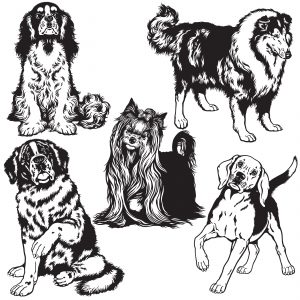
Allergies in dogs are a fairly common dog health problem, just as they are in humans. However, dogs show different symptoms when they have allergies.
Understanding these symptoms and realizing that they point to canine allergies is very important, especially if you have a dog that’s one of the breeds that is especially prone to allergies.
Breeds that commonly have allergies include beagles, boxers, bulldogs, rottweilers, pugs, schnauzers, golden retrievers, poodles, and more.
Allergies typically develop after the animal is about a year old, so if your puppy doesn’t show any signs of allergies, don’t expect that it won’t have any when it is fully grown.
Types of Dog Allergies
Dog allergies typically take one of two forms. Dogs can either be allergic to food, or they can have allergies to something in their environment.
The most common type of allergy is a dog food allergy, and sometimes it can be quite difficult to figure out exactly which food the animal is allergic to. Dog food has many different ingredients, and so an elimination diet is necessary to get to the root of food allergies.
There are also many common environmental allergies in dogs, which are similar to the things some people are allergic to. For example, many people are allergic to dust, dust mites, and pollen, and dogs can also be allergic to these things.
Symptoms of Canine Allergies
Although dogs and humans can be allergic to similar things, dogs show their symptoms quite a bit differently.
The most common symptom of any kind of allergy in a dog is excessive itching and scratching, even if it is a food allergy. However, dog vomiting and dog diarrhea can also be signs of food allergies or intolerances.
In some cases if the itching is very severe, the dog may develop a hot spot, which is an area of skin that has lost all of the hair and may be red.
Often the dog may scratch this area until it bleeds, so it is very important to prevent the animal from breaking the skin by either spraying a deterrent onto the area or by putting a special collar on the dog that prevents it from being able to reach the spot.
Treatment for Dog Allergies
Of course the simplest treatment for allergies is to remove the allergen, but sometimes allergies in dogs are so severe that additional medication or treatment may be necessary, at least until the allergen has worked itself out of your dog’s system.
One treatment is to soothe the dog’s skin by giving it an oatmeal bath. Also try washing the animal with hypoallergenic shampoos.
If your dog is allergic to pollen or other seasonal allergens, try to limit the amount of time he spends outdoors and also try to keep him from jumping into flower beds or weeds.
Sometimes the vet may prescribe a topical ointment or cream to help the area heal, especially if the dog has a hot spot. Just remember that this is only a temporary solution, and you will have to apply more later in the day.
For very severe allergic reactions that result in excessive inflammation, the vet may prescribe a steroid medication.
An antibiotic may also be necessary if the dog has scratched so much that he has developed a skin infection.
Return to Common Dog Health Problems
Return from Allergies in Dogs to Yorkshire Terriers Homepage